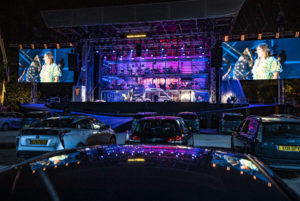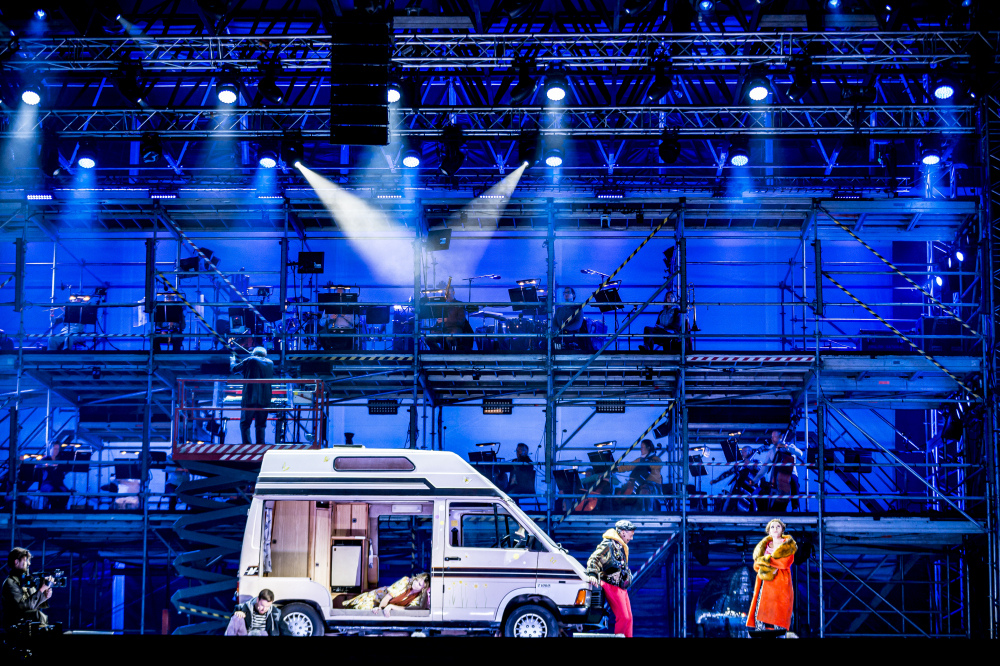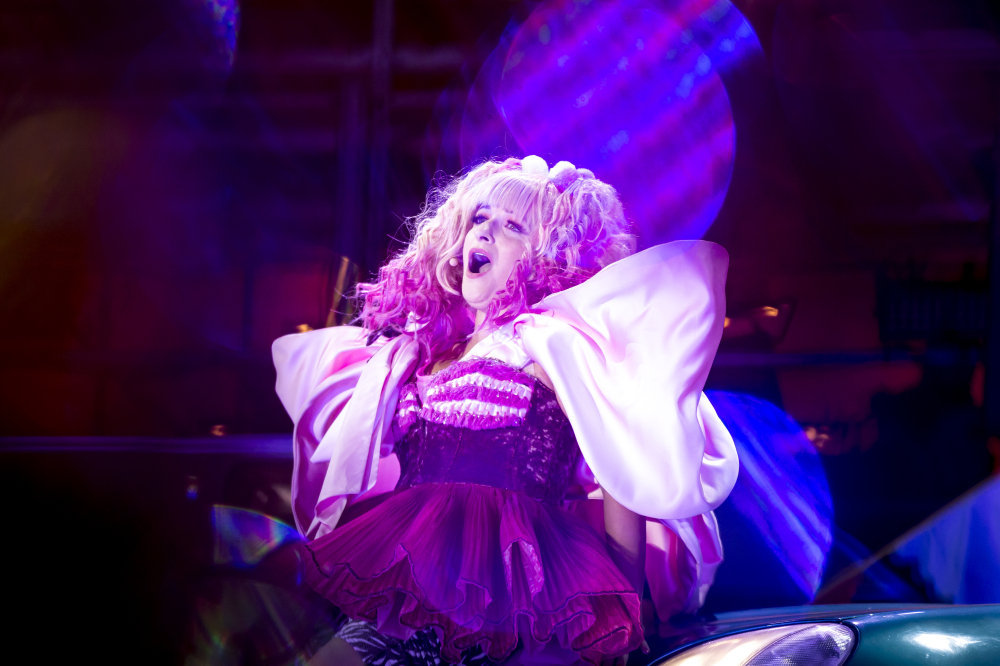
English National Opera 2020 Review: La Bohème
ENO Delivers An Operatic Experience Like No Other
By Kirsten Scott(Credit: Lloyd Winters)
The jumbotrons flash with bright colors and larger-than-life faces. The campervans are scattered across Alexandra Palace’s massive outdoor stage.
I am transported to some bizzarro Coachella performed in suburban London. I pull my coat close around me as a pervasive English damp and an all-too familiar British wind cut through the desert festival scenes. The cars beginning to line up around me, headlamps turned to the stage as if for a drive-in movie, are a picture reminiscent of 1950s Americana. No passerby would ever think that all this was for an opera. Perhaps a Rihanna concert or an indie film festival, but certainly not an opera.
And yet it is.
English National Opera (ENO) premiered its new outdoor “Drive & Live” production of Puccini’s classic “La Bohème” on September 19, 2020 to a full parking lot. It was not long before the cars were queuing for a chance to see this unique piece of opera, and by the time I attended, on closing night, it was a sold-out show. Styled after the classic drive-in movie theaters and bohemian music festivals of the mid-20th century, attendees could park their own cars or reserve an Uber—the ridesharing company partnered with ENO for the production—from which they could experience the edgy and fresh performance. At the back of the lot was a Hotel Chocolat food truck offering pre-show small bites and drinks.
As I waited in the line for my own serving of pre-show chocolate, I was engaged in pleasant small talk by another attendee of the opera. Shortly afterwards a security guard came around to check in on the cars before the show began. I thought nothing of these passing encounters until the performance started and both these seemingly innocuous men trickled onto to the stage. It became clear that the audience members would not be passive observers, as so often we are inside traditional opera houses, but instead active participants within the opera: we had entered the opera the moment we had arrived at Alexandra Palace. There were surprises at every turn, and the baton had not even dropped.

Photo: Lloyd Winters
Full-Time Immersion
The role of Benoit, the officious landlord, was cleverly cast as the security guard for the music festival who had checked our cars. Trevor Eliot Bowes sang the role with a resonant bass voice, appropriately biting in tense, dramatic moments. A tall, young man with a video camera walked from car to car recording footage that was instantaneously projected onto the two massive jumbotrons that hung over either side of the stage. With his video camera still in hand, William Thomas later joined the cast in the role of Colline, singing the famous “Coat Aria” in the final moments of the opera with gravitas and an evenly rich and fluid bass.
Condensed to two hours and sung in English rather than Italian, all the changes made sense in the context of the production. It truly was a new and ingenious “La Bohème,” the brainchild of young director PJ Harris. Conductor Martyn Brabbins led the orchestra splendidly—which was hidden on construction scaffolding at the rear of the stage—from atop a hydraulic construction lift placed behind the campervans. The machinery only enhanced the feeling of being at a music festival.
Rodolfo, Marcello, Schaunard, and Colline—the core group of friends from the opera’s beginning—meander from campervan to campervan. Rodolfo, the brooding writer, played by shining tenor David Butt Philip, speaks to friend Marcello—baritone Roderick Williams—who artistically paints a large hunk of metal and sings in a cutting and resonant voice. Williams’ costume is a picture lifted straight from 80s fashion magazines: splashes of bright color, a general bagginess to the cut, a cap, and lots of denim. The costumes throughout the show are flamboyant and fabulous, an absolute feat for costume designer Camilla Clarke who managed to fill a massive outdoor stage with a dazzling spectacle of textures, voluminous head pieces, colors and whimsy. Schaunard bursts into the piece with an energy and stage presence appropriate for his role as the life of the party. Benson Wilson’s flowing warm baritone voice makes you forget that this version of “La Bohème” is not sung in Italian.
Natalia Romaniw was sublime as the tragic figure of Mimi, exhibiting complete control and freedom over her voice. Listening to Romaniw perform Mimi’s glorious aria “Si, mi chiamano Mimi (“They Call Me Mimi”),” when the transcendent soprano’s voice soared into the most beautiful floating sustained high note over the swelling orchestra, was a gift, and the moment that I grasped the gravity of this performance. This was a groundbreaking production in so many ways. The chemistry between Romaniw and Butt Philip was another reminder of this. The audience was completely entranced by the love they shared, yet a viewer could not help but notice that they never once touched. This is of course a product of performing during a global pandemic, yet so talented were the performers and brilliant the direction that it seemed an artistic choice that their sweet and short-lived romance never once included physical contact.
Soraya Mafi as the diva Musetta makes a suitably dramatic entrance, driving through the audience of parked cars and onto the stage in her light blue convertible, honking repeatedly. Exiting her vehicle, the soprano launches seamlessly and hilariously into her famous aria “Quando m’en vo’ (“When I Go Along”).” Her bright, evenly floating voice perfectly incapsulates her flighty and fiery character as she flirts with everyone around her in a classic attempt to make Marcello jealous.

Credit: Lloyd Winters
One cannot mention Musetta without acknowledging her downtrodden boyfriend Alcindoro; given life in this performance by the bass-baritone John Savournin. Savournin brilliantly portrayed the pathetically devoted and ridiculous character, giving the role charisma while exhibiting his great gift for comedic timing.
The cast was wonderfully rounded out by Parpignol, performed by tenor David Newman with absolute and hysterical commitment to his outrageous makeup and costume. Parpignol, traditionally performed as a toy seller, in this modern retelling became a festival hype-man who, with a great deal of jaunt, got the drive-in audience energized and inspired to viscerally engage with the opera.
All the singers were excellently microphoned for the performance, ensuring that the audience members were able to not only listen to the music through the open windows of their vehicles but tune in to the opera through their cars’ radios. The sound designers, captained by the amazing Ian Dearden, managed to capture so much nuance in the voices throughout the production. The cherry on the top of the festival cake was the spectacular use of lighting under the stewardship of Natasha Chivers. All technical aspects combined transported the car-bound late-evening London crowd to the closest thing to Coachella anyone can attend these days.
Changing Things Up
In a daring move, scenes were broken up with interludes of excerpted orchestral Puccini backed by hip hop beats, with dance choreography by Dannielle ‘Rhimes’ Lecointe. Breakdancers took to the stage to improvise and energize the transitional moments, lending an authenticity to the music festival atmosphere that I would venture to say no other production has ever attempted.
Closing night Dance Captain Jackie Kibuka, and the four other incredible dancers—Corinne Holt, Kennedy Harris, Zion Battles and David Cottle—were not only talented but also crucial in contemporizing the 19th century story. Art collides in all forms in “La Bohème,” and ENO’s production was a modern representation of that collision.
“La Bohème” was written in 1895 by Giacomo Puccini and is, to this day, one of the most performed operas in the world. The story has inspired countless other works: namely the Broadway hit Rent by Jonathan Larsen, and the movie “Moulin Rouge” directed by Baz Luhrmann. It is incredibly difficult to do something truly innovative with a piece performed so often. As I watched I realized that with this performance ENO had achieved that near-impossible task.
PJ Harris’ production with ENO is a revelation: a completely fresh, vibrant, eclectic, inventive “La Bohème” that pushes so many artistic and musical boundaries. It was not just the setting of a drive-in theater that catapulted the show into a new and fantastic dimension of opera. The wild costumes, the vibrant setting, the abridged English, the nods to modern music and dance, and the cutting-edge lighting and sound design all prove that opera will not only just survive this pandemic, it will thrive and grow as we continue to adapt and innovate beyond what we have previously thought was possible.
After my night at the opera, at the drive-in, at the music festival, I can confidently say that ENO is at the forefront of an opera revolution.


